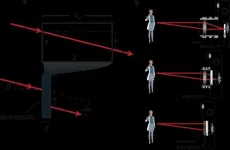New twist on DNA data storage lets users preview stored files
2021-06-10
(Press-News.org) Researchers from North Carolina State University have turned a longstanding challenge in DNA data storage into a tool, using it to offer users previews of stored data files - such as thumbnail versions of image files.
DNA data storage is an attractive technology because it has the potential to store a tremendous amount of data in a small package, it can store that data for a long time, and it does so in an energy-efficient way. However, until now, it wasn't possible to preview the data in a file stored as DNA - if you wanted to know what a file was, you had to "open" the entire file.
"The advantage to our technique is that it is more efficient in terms of time and money," says Kyle Tomek, lead author of a paper on the work and a Ph.D. student at NC State. "If you are not sure which file has the data you want, you don't have to sequence all of the DNA in all of the potential files. Instead, you can sequence much smaller portions of the DNA files to serve as previews."
Here's a quick overview of how this works.
Users "name" their data files by attaching sequences of DNA called primer-binding sequences to the ends of DNA strands that are storing information. To identify and extract a given file, most systems use polymerase chain reaction (PCR). Specifically, they use a small DNA primer that matches the corresponding primer-binding sequence to identify the DNA strands containing the file you want. The system then uses PCR to make lots of copies of the relevant DNA strands, then sequences the entire sample. Because the process makes numerous copies of the targeted DNA strands, the signal of the targeted strands is stronger than the rest of the sample, making it possible to identify the targeted DNA sequence and read the file.
However, one challenge that DNA data storage researchers have grappled with is that if two or more files have similar file names, the PCR will inadvertently copy pieces of multiple data files. As a result, users have to give files very distinct names to avoid getting messy data.
"At some point it occurred to us that we might be able to use these non-specific interactions as a tool, rather than viewing it as a problem," says Albert Keung, co-corresponding author of a paper on the work and an assistant professor of chemical and biomolecular engineering at NC State.
Specifically, the researchers developed a technique that makes use of similar file names to let them open either an entire file or a specific subset of that file. This works by using a specific naming convention when naming a file and a given subset of the file. They can choose whether to open the entire file, or just the "preview" version, by manipulating several parameters of the PCR process: the temperature, the concentration of DNA in the sample, and the types and concentrations of reagents in the sample.
"Our technique makes the system more complex," says James Tuck, co-corresponding author of the paper and a professor of computer engineering at NC State. "This means that we have to be even more careful in managing both the file-naming conventions and the conditions of PCR. However, this makes the system both more data-efficient and substantially more user friendly."
The researchers demonstrated their technique by saving four large JPEG image files in DNA data storage and retrieving thumbnails of each file, as well as the full, high-resolution files in their entirety.
"Although we have only stored image files, this technology is broadly compatible with other file types. It also provides this new functionality without added cost," says Kevin Volkel, co-author of the work and a Ph.D. student at NC State.
The new "file preview" technique is also compatible with the DNA Enrichment and Nested Separation (DENSe) system that the researchers created to make DNA data storage more practical. DENSe effectively made DNA storage systems more scalable by introducing improved techniques for data file labeling and retrieval.
"We're currently looking for industry partners to help us explore the technology's commercial viability," Keung says.
The paper, "Promiscuous Molecules for Smarter File Operations in DNA-based Data Storage," will be published June 10 in Nature Communications. The paper was co-authored by Elaine Indermaur, a former undergraduate at NC State.
INFORMATION:
The work was done with support from the National Science Foundation, under grants 1650148, 1901324 and 2027655; and from a Department of Education Graduate Assistance in Areas of National Need Fellowship.
ELSE PRESS RELEASES FROM THIS DATE:
2021-06-10
DALLAS, June 10, 2021 -- The distance a stroke patient must travel to receive care at a certified stroke center differs by race, age, income and insurance status, with the largest disparities found among rural residents and American Indians, according to a combined analysis of U.S. census data and road maps published today in Stroke, a journal of the American Stroke Association, a division of the American Heart Association.
Treatment for ischemic stroke, a blockage in an artery that supplies blood to the brain, restores blood flow to the brain. Rapid treatment is essential to reduce disability. Blood flow may be reestablished by administering intravenous clot-busting medication within 4.5 hours after the onset of stroke ...
2021-06-10
Polymetallic nodules and crusts cover many thousands of square kilometres of the world's deep-sea floor. They contain valuable metals and rare earth elements and are therefore of great economic interest. To date, there is no market-ready technology for deep-seabed mining. But it is already clear that interventions in the seabed have a massive and lasting impact on the areas affected. This is also confirmed by a study now published by Tanja Stratmann from the Max Planck Institute for Marine Microbiology in Bremen, Germany, and researchers from the Senckenberg am Meer Institute in Wilhelmshaven, Germany, and the Dutch research institute NIOZ.
In their study, Stratmann and her colleagues used data from ...
2021-06-10
When nature vanishes, people of color and low-income Americans disproportionally lose critical environmental and health benefits--including air quality, crop productivity and natural disease control--a new study in Nature Communications finds.
The University of Vermont research is the first national study to explore the unequal impacts on American society--by race, income and other demographics--of projected declines in nature, and its many benefits, across the United States.
Focusing on three vital ecosystem services--air quality, crop pollination, and control of insect-borne disease (West Nile virus), researchers project that these benefits of nature will decrease for non-white people by an average of 224%, ...
2021-06-10
Can you imagine one day using a telescope as thin as a sheet of paper, or a much smaller and lighter high-performance camera? Or no longer having that camera bump behind your smartphone?
In a paper published in Nature Communications, researchers from the University of Ottawa have proposed a new optical element that could turn these ideas into reality by dramatically miniaturizing optical devices, potentially impacting many of the applications in our lives.
To learn more about this project, we talked to lead author Dr. Orad Reshef, a senior postdoctoral fellow in the Robert Boyd Group, and research lead Dr. Jeff Lundeen, who is the Canada Research Chair in Quantum Photonics, Associate Professor in the ...
2021-06-10
A class of drug called monoamine oxidase inhibitors is commonly prescribed to treat depression; the medications work by boosting levels of serotonin, the brain's "happiness hormone."
A new study by UCLA researchers suggests that those drugs, commonly known as MAOIs, might have another health benefit: helping the immune system attack cancer. Their findings are reported in two papers, which are published in the journals Science Immunology and Nature Communications.
"MAOIs had not been linked to the immune system's response to cancer before," said Lili Yang, senior author of the study and a member of the Eli and Edythe Broad Center of Regenerative Medicine and Stem Cell Research at UCLA. "What's especially exciting is that this is a very well-studied and ...
2021-06-10
The largest study of its kind has unveiled new insights into how genes are regulated in dementia, including discovering 84 new genes linked to the disease.
Led by the University of Exeter, the international collaboration combined and analysed data from more than 1,400 people across six different studies, in a meta-analysis published in Nature Communications. These studies had used brain samples from people who had died with Alzheimer's disease. The project, funded by Alzheimer's Society and supported by the Medical Research Council and the National Institutes for ...
2021-06-10
UNIVERSITY OF TORONTO & CARLETON UNIVERSITY
New research published online in the journal Substance Use & Misuse is good news for those struggling with alcohol dependence: the possibility of ending this dependency gets easier with age. Moreover, more than half of individuals who have been dependent on alcohol are free of any addictions or mental illness, and nearly 40% are in excellent mental health.
Using data drawn from Statistics Canada's Canadian Community Health Survey-Mental Health, researchers examined a nationally representative sample of 820 adult Canadians with a history of alcohol dependence to 19,945 who had never been addicted to alcohol.
They found that in the past year, 71% of ...
2021-06-10
PISCATAWAY, NJ - Underage youth consumed $17.5 billion worth, or 8.6 percent, of the alcoholic drinks sold in 2016. Products from three alcohol companies--AB Inbev, MillerCoors and Diageo--accounted for nearly half of youth consumption, according to a new study published in the Journal of Studies on Alcohol and Drugs.
Data collected in a landmark study of youth alcohol consumption by brand enabled the authors to calculate the first estimate in nearly 20 years of the monetary value of youth alcohol consumption. And for the first time, they were able to attribute those revenues to specific companies.
"The alcohol industry has said they don't want minors to drink, ...
2021-06-10
ROCHESTER, Minn. -- Treating transplant patients with mild to moderate cases of COVID-19 with monoclonal antibodies is safe and helps prevent serious illness, according to a Mayo Clinic study recently published in Open Forum Infectious Diseases. These results are especially important because transplant patients who are infected with COVID-19 have a higher risk of severe illness and death.
"Monoclonal antibody therapy is really important for the transplant population because they are less likely to develop their own immunity. Providing them with these antibodies helps them recover from COVID-19," says Raymund Razonable, M.D., a Mayo Clinic infectious diseases specialist and the study's senior ...
2021-06-10
When herring are filleted, more than half their weight becomes a low-value 'side stream' that never reaches our plates - despite being rich in protein and healthy omega-3 fatty acids. Now, scientists from Chalmers University of Technology, Sweden, have developed a special dipping solution, with ingredients including rosemary extract and citric acid, which can significantly extend the side streams' shelf life, and increase the opportunities to use them as food.
Techniques for upgrading these side-streams to food products such as minces, protein isolates, hydrolysates and oils are already available today, and offer the chance to reduce the current practices of using them for animal feed, ...
LAST 30 PRESS RELEASES:
[Press-News.org] New twist on DNA data storage lets users preview stored files


